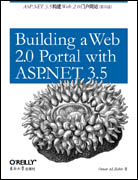
ASP.NET 3.5构建Web 2.0门户网站(影印版)
出版时间:2008年05月
页数:290
“如果您把创建高性能的、现代化的、基于Ajax技术的ASP.NET网站作为一项严肃的工作, 那么这本《ASP.NET 3.5构建Web 2.0门户网站》正是为您所准备的。”
——Mike Pope, 微软用户教育
或许您认为自己对ASP.NET已经相当了解,请再考虑一下。这本卓然不群的指南为使用ASP.NET 3.5和其他前沿微软技术构建网站提供了大师级课程指导。它教您如何开发坚若磐石的Web门户应用程序,每天能够承受数百万次的点击,同时确保应对扩展性和安全性的压力。 这些程序不仅可以用于面向大众消费群体的主页,也可用于企业发布高效内容聚合的消息板(dashboard)。
Pageflakes的创始人和首席技术官Omar AL Zabir所著的这本《ASP.NET 3.5构建Web 2.0门户网站》展示了如何使用ASP.NET 3.5、ASP.NET AJAX、Windows Workflow Foundation、LINQ和.NET 3.5来开发类似于My Yahoo!、iGoogle和Pageflakes的门户站点。在书中,AL Zabir构建了一个支持Ajax的开源门户原型(可以通过网址www.dropthings.com找到),并且向您一一讲解设计和架构中面临的挑战、高级Ajax概念、性能优化技巧和服务器端扩展性问题。
通过本书您将学到:
* 实现一个高度松耦合的架构,紧跟流行的n层结构和基于构件的应用程序模型
* 提供拖放功能,并且使用ASP.NET 3.5构建Web软件层的服务器端
* 运用LINQ建立数据访问层,并使用Windows Workflow Foundation建立作为工作流集合的业务逻辑层
* 使用JavaScript开发客户端构件以获得更快的性能和更好的缓存效果
* 发挥ASP.NET AJAX框架的最大效能以获得速度更快、具有更多动态效果和更好可扩展性的站点
* 构建一个客户Web服务调用句柄以克服ASP.NET AJAX 1.0的缺点,从而得到异步、支持事务处理和缓存友好的网络服务
Omar AL Zabir是Pageflakes的创始人和首席技术官、微软MVP、受欢迎的.NET博客作者(http://msmvps.com/omar)以及Code Project的频繁贡献者。2006年,Pageflakes在西雅图地区SEOmoz.org进行的一次评审中,排名超过了iGoogle、Live.com、Netvibes和Protopage。
——Mike Pope, 微软用户教育
或许您认为自己对ASP.NET已经相当了解,请再考虑一下。这本卓然不群的指南为使用ASP.NET 3.5和其他前沿微软技术构建网站提供了大师级课程指导。它教您如何开发坚若磐石的Web门户应用程序,每天能够承受数百万次的点击,同时确保应对扩展性和安全性的压力。 这些程序不仅可以用于面向大众消费群体的主页,也可用于企业发布高效内容聚合的消息板(dashboard)。
Pageflakes的创始人和首席技术官Omar AL Zabir所著的这本《ASP.NET 3.5构建Web 2.0门户网站》展示了如何使用ASP.NET 3.5、ASP.NET AJAX、Windows Workflow Foundation、LINQ和.NET 3.5来开发类似于My Yahoo!、iGoogle和Pageflakes的门户站点。在书中,AL Zabir构建了一个支持Ajax的开源门户原型(可以通过网址www.dropthings.com找到),并且向您一一讲解设计和架构中面临的挑战、高级Ajax概念、性能优化技巧和服务器端扩展性问题。
通过本书您将学到:
* 实现一个高度松耦合的架构,紧跟流行的n层结构和基于构件的应用程序模型
* 提供拖放功能,并且使用ASP.NET 3.5构建Web软件层的服务器端
* 运用LINQ建立数据访问层,并使用Windows Workflow Foundation建立作为工作流集合的业务逻辑层
* 使用JavaScript开发客户端构件以获得更快的性能和更好的缓存效果
* 发挥ASP.NET AJAX框架的最大效能以获得速度更快、具有更多动态效果和更好可扩展性的站点
* 构建一个客户Web服务调用句柄以克服ASP.NET AJAX 1.0的缺点,从而得到异步、支持事务处理和缓存友好的网络服务
Omar AL Zabir是Pageflakes的创始人和首席技术官、微软MVP、受欢迎的.NET博客作者(http://msmvps.com/omar)以及Code Project的频繁贡献者。2006年,Pageflakes在西雅图地区SEOmoz.org进行的一次评审中,排名超过了iGoogle、Live.com、Netvibes和Protopage。
- Preface
- 1. Introducing Web Portals and Dropthings.com
- Defining a Web Portal
- Defining a Web 2.0 Portal
- Using a Web Portal
- Navigating Dropthings
- Using ASP.NET Using C# 3.0 and .NET 3.5
- Summary
- 2. Architecting the Web Portal and Widgets
- Using a Widget Framework
- Adding Widgets
- Maximizing the First-Visit Experience
- Rendering a Second-Visit Experience
- Improving ASP.NET AJAX Performance
- Adding Authentication and Authorization
- Preventing Denial-of-Service Attacks
- Summary
- 3. Building the Web Layer Using ASP.NET AJAX
- Implementing the Start Page of a Web Portal
- Building a Custom Drag-and-Drop Extender for a Multicolumn Drop Zone
- Implementing WidgetContainer
- Building Widgets
- Page Switching: Simulating a Nonpostback Experience
- Using the Profile Object Inside a Web Service
- Implementing Authentication and Authorization
- Implementing Logout
- Summary
- 4. Building the Data and Business Layers Using .NET 3.5
- Introducing LINQ to SQL
- Building the Data Access Layer Using LINQ to SQL
- Introducing Windows Workflow Foundation
- Building the Business Layer Using WF
- Implementing the DashboardFacade
- Summary
- 5. Building Client-Side Widgets
- Delaying Server-Side Widget Loading
- Content Proxy
- Building a Client-Side RSS Widget
- Building a Client-Side Flickr Widget
- Summary
- 6. Optimizing ASP.NET AJAX
- Combining Multiple Ajax Calls into One Call
- Timing and Ordering Ajax Calls to the Server
- Using HTTP GET Calls Instead of HTTP POST
- Working with the this Function
- Summary
- 7. Creating Asynchronous, Transactional, Cache-Friendly Web Services
- Scalability Challenges with Web Services
- Asynchronous Web Methods
- Modifying the ASP.NET AJAX Framework to Handle Web Service Calls
- Developing Your Own Web Service Handler
- Making an Asynchronous and Cache-Friendly Proxy
- Scaling and Securing the Content Proxy
- Summary
- 8. Improving Server-Side Performance and Scalability
- Instrumenting Your Code to Identify Performance Problems
- Optimizing the HTTP Pipeline
- Optimizing ASP.NET 2.0/3.5 Before Going Live
- Optimizing Queries in the ASP.NET Membership Tables
- Optimizing the ASP.NET 2.0/3.5 Profile Provider Before You Go Live
- ASP.NET Production Challenges
- Redirecting Traffic from an Old Web Site to a New One
- Summary
- 9. Improving Client-Side Performance
- Understanding Web Caching
- Content Delivery Networks
- Optimizing Internet Explorer JavaScript Performance
- Reducing the Web Service Call Payload
- Loading the UI on Demand
- Using Read-Ahead Caching for Ajax Calls
- Hiding HTML Inside <textarea>
- Summary
- 10. Solving Common Deployment, Hosting, and Production Challenges
- Deploying Your Web Site in a Web Farm
- Thirteen Production Disasters That Could Happen at Anytime
- Choosing the Right Hosting Provider
- Choosing a Web Site Monitoring Tool
- Configuring Proper Performance Counters
- Summary
- Index
书名:ASP.NET 3.5构建Web 2.0门户网站(影印版)
作者:Omar AL Zabir 著
国内出版社:东南大学出版社
出版时间:2008年05月
页数:290
书号:978-7-5641-0910-3
原版书出版商:O'Reilly Media
The animal on the cover of Building a Web 2.0 Portal with ASP.NET 3.5 is a giant
green sea anemone (Anthopleura xanthogrammica). These anemones are found on
rocks in tidal pools, rocky outcroppings, and concrete pilings from Alaska to Panama
in intertidal and subtidal zones. The giant green sea anemone varies in size but can
reach heights of 30 cm, have a 17 cm base, and a crown or head of 25 cm.
The giant green sea anemone gets its color from green pigment in its epidermis, so
the more sunlight it is exposed to, the more green it becomes. This anemone is a solitary
and mostly stationary invertebrate from the Cnidaria phylum, which also
includes jellyfish. Like a jellyfish, the giant green sea anemone stings its prey with
poison tentacles and then draws the food to its mouth. These anemones enjoy a
carnivorous diet of mussels, sea urchins, and small fish, and have been known to eat
a giant crab in 15 minutes. Clownfish are immune to its stings and often have symbiotic
relationships with anemones. Scientists are experimenting with the poison as a
cardiotonic to help ailing human hearts.
The enemies of the giant green anemone include starfish, snails, and sea slugs.
However, development in coastal areas, pollution, human foot traffic, and harvesting
for home aquariums also pose significant threats.
green sea anemone (Anthopleura xanthogrammica). These anemones are found on
rocks in tidal pools, rocky outcroppings, and concrete pilings from Alaska to Panama
in intertidal and subtidal zones. The giant green sea anemone varies in size but can
reach heights of 30 cm, have a 17 cm base, and a crown or head of 25 cm.
The giant green sea anemone gets its color from green pigment in its epidermis, so
the more sunlight it is exposed to, the more green it becomes. This anemone is a solitary
and mostly stationary invertebrate from the Cnidaria phylum, which also
includes jellyfish. Like a jellyfish, the giant green sea anemone stings its prey with
poison tentacles and then draws the food to its mouth. These anemones enjoy a
carnivorous diet of mussels, sea urchins, and small fish, and have been known to eat
a giant crab in 15 minutes. Clownfish are immune to its stings and often have symbiotic
relationships with anemones. Scientists are experimenting with the poison as a
cardiotonic to help ailing human hearts.
The enemies of the giant green anemone include starfish, snails, and sea slugs.
However, development in coastal areas, pollution, human foot traffic, and harvesting
for home aquariums also pose significant threats.
购买选项